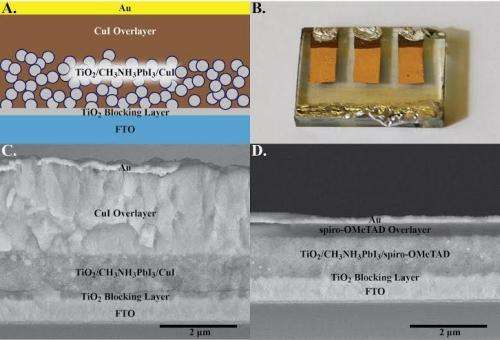January 7, 2014 report
Perovskite solar cells become even more promising with cheaper materials

(Phys.org) —Due to their rapid improvements in a short amount of time, perovskite solar cells have become one of today's most promising up-and-coming photovoltaic technologies. Currently, the record efficiency for a perovskite solar cell is 15% and expected to improve further. Although the perovskite material itself is relatively inexpensive, the best devices commonly use an expensive organic hole-conducting polymer, called spiro-OMeTAD, which has a commercial price that is more than 10 times that of gold and platinum.
In a new study, Jeffrey A. Christians, Raymond C. M. Fung, and Prashant V. Kamat from the University of Notre Dame in Indiana have found that copper iodide, an inexpensive inorganic hole-conducting material, may serve as a possible alternative to spiro-OMeTAD. Although the efficiency of perovskite solar cells containing copper iodide measured in this study is not quite as high as those containing spiro-OMeTAD, the copper iodide devices exhibit some other advantages that, overall, suggest that they could lead to the development of inexpensive, high-efficiency perovskite solar cells.
"The hole conductor is currently the most expensive part of perovskite solar cells," Christians told Phys.org. "Other organic hole conductor alternatives to spiro-OMeTAD have been investigated, but these alternatives still remain very expensive. This is the first reported inorganic hole conductor for perovskite solar cells, and is much less expensive than previously reported hole conductor materials. This low-cost hole conductor could further lower the cost of these already inexpensive solar cells."
Perovskite solar cells, as a whole, are attractive because perovskite is a class of materials with a particular crystal structure that is the same as that of calcium titanium dioxide. This structure gives solar cells high charge-carrier mobilities and long diffusion lengths, allowing the photo-generated electrons and holes to travel long distances without energy loss. As a result, the electrons and holes can travel through thicker solar cells, which absorb more light and therefore generate more electricity than thin ones.
Although this study marks the first time that copper iodide has been investigated for use as hole conductors in perovskite solar cells, copper-based hole conductors have previously shown promise for use in dye-sensitized and quantum dot-sensitized solar cells. Part of their appeal is their high conductivity. In fact, copper iodide hole conductors exhibit an electrical conductivity that is two orders of magnitude higher than spiro-OMeTAD, which allows for a higher fill factor, which in turn determines the solar cell's maximum power.
Despite the copper iodide's high conductivity, the results of the current study showed that perovskite solar cells made with copper iodide hole conductors have a power conversion efficiency of 6.0%, lower than the 7.9% measured here for cells with spiro-OMeTAD hole conductors. The researchers attribute this shortcoming to the fact that spiro-OMeTAD solar cells have exceptionally high voltages. In the future, they think that the voltages of copper iodide solar cells can be increased, in particular by reducing the high recombination rate. The researchers calculated that, if they could achieve the highest parameter values observed in this study, the resulting copper iodide solar cell would have an efficiency of 8.3%.
The researchers also observed that the copper iodide solar cells exhibited another surprising advantage, which is good stability. After two hours of continuous illumination, the copper iodide cells showed no decrease in current, while the current of the spiro-OMeTAD cells decreased by about 10%. The researchers plan to further improve the devices in the future.
"We are currently working to understand the cause of the low voltage in copper iodide-based perovskite solar cells," Christians said. "With further work, we aim to increase the stability and improve the efficiency of these solar cells above 10%.
"The biggest challenge facing perovskite solar cells is long-term stability in a wide range of environments. The efficiency of the best perovskite solar cells is competitive with current commercial technologies, and they are potentially much cheaper. However, commercial solar cells must last 20-30 years with minimal degradation, and whether or not perovskite solar cells are capable of this type of long-term stability is currently an unanswered question."
More information: More information: Jeffrey A. Christians, et al. "An Inorganic Hole Conductor for Organo-Lead Halide Perovskite Solar Cells. Improved Hole Conductivity with Copper Iodide." Journal of the American Chemical Society. DOI: 10.1021/ja411014k
Journal information: Journal of the American Chemical Society
© 2014 Phys.org





















